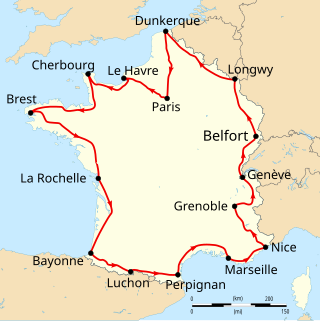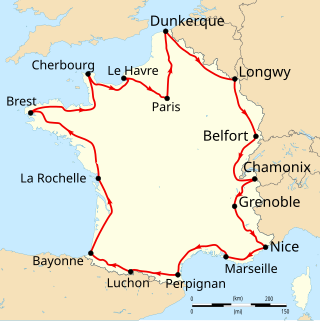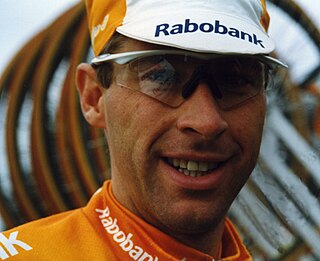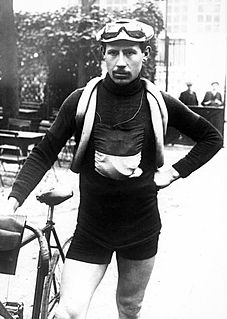
François Faber was a Luxembourgian racing cyclist. He was born in France. He was the first foreigner to win the Tour de France in 1909, and his record of winning 5 consecutive stages still stands. He died in World War I while fighting for France. Faber was known for his long solo's; he is the only rider in Tour de France history to lead solo more than 1000 km.

Tom Boonen is a Belgian former road bicycle racer, who competed as a professional between 2002 and 2017 for the U.S. Postal Service and Quick-Step Floors teams and a professional racing driver who currently competes in Belcar, having previously competed in the NASCAR Whelen Euro Series. Boonen won the 2005 UCI World Road Race Championships, and was a single-day road specialist with a strong finishing sprint. He won the cycling monuments Paris–Roubaix 4 times and the Tour of Flanders 3 times, among many other prestigious victories, such as prevailing 5 times in the E3 Harelbeke, winning 6 stages of the Tour de France and winning the Overall title of the Tour of Qatar 4 times.

Andreas Klöden is a German former professional road bicycle racer, who competed as a professional between 1998 and 2013. His major achievements include a bronze medal at the 2000 Olympic Games and finishing second in the general classification at the 2004 and 2006 Tour de France. Klöden is a tall, lightly built racer with enough strength to place high in the overall classifications of the Grand Tours, but his performances have been afflicted by injuries.

The 1914 Tour de France was the 12th edition of the Tour de France, taking place in 15 stages from 28 June to 26 July. The total distance was 5,380 kilometres (3,340 mi) and the average speed of the riders was 26.835 kilometres per hour (16.674 mph). It was won by the Belgian cyclist Philippe Thys.

The 1906 Tour de France was the fourth of the edition Tour de France, and second to use the point system. Taking place from 4 to 29 July the total race distance was 4,637 kilometres (2,881 mi) run over 13 stages, with the winner averaging 24.463 kilometres per hour (15.201 mph). New in this year were the mountain climbs in the Massif Central. Like its predecessors, it still had cheating and sabotage taking place. Four competitors were disqualified for taking trains as a shortcut and spectators threw nails in the road. However, this did not stop René Pottier from taking a big lead in the first stages. Free of tendinitis that plagued his 1905 chances, he dominated the entire race.

Henri Pélissier was a French racing cyclist from Paris and champion of the 1923 Tour de France. In addition to his 29 career victories, he was known for his long-standing feud with Tour founder Henri Desgrange and for protesting against the conditions endured by riders in the early years of the Tour. He was killed by his lover with the gun that his wife had used to commit suicide.

Cyprien Gustave Garrigou was one of the best professional racing cyclists of his era. He rode the Tour de France eight times and won once. Of 117 stages, he won eight, came in the top ten 96 times and finished 65 times in the first five.

Émile Georget was a French road racing cyclist. Born in Bossay-sur-Claise, he was the younger brother of cyclist Léon Georget. He died at Châtellerault.

The 1911 Tour de France was the ninth edition of the Tour de France, taking place from 2 to 30 July. It was composed of 15 stages over 5,343 kilometres (3,320 mi), ridden at an average speed of 27.322 km/h. The results were computed by giving each rider points according to his finishing position on each stage, and the rider with the fewest points at the end of the race won the overall competition. It was a gruelling tour, with the longest stage, 470 km long, taking almost 18 hours for the fastest riders to complete. Out of the 84 riders who started the tour, only 28 completed the race. After the introduction of the Pyrenees in the previous edition, in 1911 the Alps were first visited; for this addition, the 1911 edition has been named the first modern Tour.

The 1920 Tour de France was the 14th edition of the Tour de France, taking place from 27 June to 27 July. It consisted of 15 stages over 5,503 kilometres (3,419 mi), ridden at an average speed of 24.072 kilometres per hour (14.958 mph). It was won by Belgian Philippe Thys, making him the first cyclist to win the Tour de France three times. The Belgians dominated this Tour: 12 of the 15 stages were won by Belgians, and the first eight cyclists in the final classification were Belgian.

Marc Wauters is a former Belgian cyclist who was professional from 1991 until 2006. The 2004 Olympian, nicknamed The Soldier was a member of the Rabobank cycling team of the UCI ProTour since 1998 and had to end his career several weeks short because of a broken collarbone which he suffered during a training on 20 September 2006.
Giuseppe "Pino" Cerami was a Belgian road bicycle racer. He joined the professional peloton in 1946 as an independent. Born in Misterbianco, Sicily, Italy he was naturalised as a Belgian on 16 March 1956.
Félicien Vervaecke was a Belgian professional cyclist from 1930 to 1939. In the Tour de France he showed good results, finishing three times on the podium. In 1935 and 1937 he won the mountain classification, and overall he won six stages. In the 1936 Tour de France, Vervaecke was on his way to the second place, but bad luck prevented it. First his bicycle broke, and he had to convince a spectator to lend his. Then he suffered a flat tire, and Tour officials forced him to wait for the reserve car. Antonin Magne passed him. When Vervaecke got his tire, he raced back to Magne, and finished 18 seconds behind him. But he still finished third, as he received 10 minutes penalty because his wife had given him drinks during the race, which was not allowed. In the 1937 Tour de France, Vervaecke won the mountain classification despite not finishing the race, something no longer allowed.

Peugeot team was a French professional cycling team that promoted and rode Peugeot racing bikes.

Alcyon was a French professional cycling team that was active from 1905 to 1959, and returned in 1961 and 1962. It was started by Alcyon, a French bicycle, automobile and motorcycle manufacturer.

Marcel Buysse was a Belgian racing cyclist.

Louis Mottiat was a Belgian professional road bicycle racer. Mottiat was born in Bouffioulx, and because of his endurance was nicknamed 'the iron man'. His career was interrupted by World War I. He died in Gilly, aged 82.

Cyrille Van Hauwaert was a Belgian professional road bicycle racer, known for winning classics as Bordeaux–Paris, Milan–San Remo and Paris–Roubaix. In 1909 he won the first stage of the Tour de France, and was leading the general classification for one day.

Maurice Brocco was a French professional road bicycle racer between 1906 and 1927. He was born into a family of Swiss-Italian immigrants. In 1911 he won a stage in the Tour de France. He participated six times in the Tour de France, but finished the race only once. In his later career he was successful in six-day races.

Jef Demuysere was a Belgian professional road bicycle racer. He finished on the podium of the Tour de France in 1929 and 1931, and on the podium of the Giro d'Italia in 1932 and 1933.


















